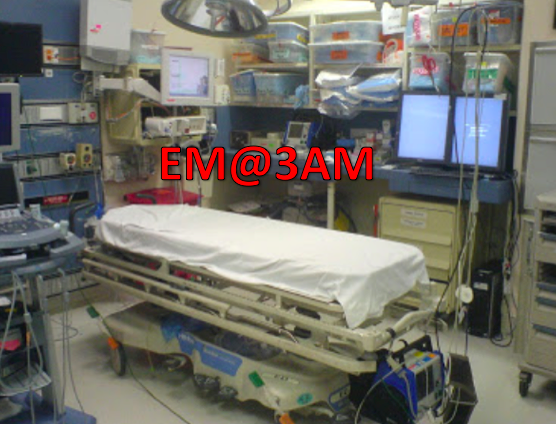Author: Erica Simon, DO, MHA (@E_M_Simon, EM Chief Resident, SAUSHEC, USAF) // Edited by: Alex Koyfman, MD (@EMHighAK, EM Attending Physician, UT Southwestern Medical Center / Parkland Memorial Hospital) and Brit Long, MD (@long_brit, EM Attending Physician, SAUSHEC, USAF)
Welcome to EM@3AM, an emdocs series designed to foster your working knowledge by providing an expedited review of clinical basics. We’ll keep it short, while you keep that EM brain sharp.
A 37 year-old-male, with a previous medical history of hypertension and tobacco abuse, presents to the emergency department for severe abdominal pain associated with nausea and vomiting. The man reports the onset of his symptoms as two hours prior to arrival; approximately 30 minutes following “a little bit more than his daily bump” of cocaine. He denies a personal or familial history of cardiac disease, aortic dissection, and cardiac arrhythmia. He denies sick contacts and recent travel.
Initial VS: BP 189/99, HR 136, T 101.9F Oral, RR 18, SpO2 97% on room air.
Physical examination:
General: Diaphoretic male who appears older than stated age; in severe distress secondary to abdominal pain.
CV: Tachycardia, no murmurs, rubs, or gallops.
Pulm: Lungs CTAB.
Abdomen: Soft, non-distended, no guarding, or rebound.
Bedside aortic ultrasound: WNL.
What’s the next step in your evaluation and treatment?
Answer: Cocaine Toxicity1-4
- Epidemology:1 According to the 2014 and 2015 National Surveys on Drug Use and Health, 1.7 million U.S. adults (ages 18-25) report the use of cocaine during the previous year (= 1 of every 20 young adults in the nation). In 2015, cocaine overdose was the cause of death in 6,800 individuals belonging to this age group.
- Pathophysiology:2 Cocaine use may result in (lists not all encompassing):
- CNS: Cerebral ischemia/infarct, intraparenchymal or subarachnoid hemorrhage, cerebral artery vasospasm, cerebral vasculitis, cerebral atrophy, and cerebral vascular thrombosis.
- Cardiac: Myocardial ischemia/infarct, cardiac arrhythmias, dilated cardiomyopathy, infective endocarditis (IVDA), aortic rupture/dissection, acceleration of coronary atherosclerosis.
- Pulmonary: Nasal septal perforation, oropharyngeal ulceration, inhalational injuries (smoking crack cocaine), pneumomediastinum, pneumothorax, pulmonary infarct, hypersensitivity pneumonitis.
- GI: Gastroduodenal ulceration/perforation, intestinal infarct/perforation, colitis.
- Renal: ARF secondary to rhabdomyolysis, renal infarct.
- OB: Placental abruption, low birth weight, microcephaly.
- Psych: Paranoia, delirium, suicidal ideation.
- Clinical Manifestations:2
- Sympathomimetic toxidrome +/- signs and symptoms associated with the conditions detailed above.
- Evaluation and Treatment:
- Assess the ABCs and obtain vital signs.
- Obtain an EKG
- Numerous cardiac dysrhythmias and conduction disturbances are associated with cocaine use:
- Sinus tachycardia, SVT, VT, Vfib, bundle branch blocks, complete heart block, AIVR, etc.3
- Numerous cardiac dysrhythmias and conduction disturbances are associated with cocaine use:
- Perform a thorough H&P.
- Utilize the H&P to direct laboratory evaluation and imaging:
- E.g. Cocaine abuse + abdominal pain => concern for aortic pathology or intestinal ischemia/infarct or colitis:
- Bedside US
- CBC, BMP, lactate, +/- type and screen PRN
- CT aorta vs. CT abdomen/pelvis w contrast
- Consider a UDS: cocaine metabolites can be detected in the urine within 5 minutes of IV administration and up to 48 hours following ingestion.2
- Note: Concern for body packing = obtain a KUB.
- E.g. Cocaine abuse + abdominal pain => concern for aortic pathology or intestinal ischemia/infarct or colitis:
- Treatment:
- Address the sympathomimetic toxidrome and cocaine-induced condition as applicable:
- Agitation: Benzodiazepines.
- Hypertension: Avoid B-blockers (unopposed α-adrenergic activity) and calcium channel blockers (may potentiate seizures and death).2 Phentolamine may be administered.
- If diastolic pressure > 120 mmHg, hydralazine 25 mg IM or IV is recommended.2
- Hyperthermia: Cooling measures to reduce core body temperature to 101°F within 30-45 mins of presentation.2
- Rhabdomyolysis: IVF therapy with a goal UOP of 2 mL/kg/hr.2
- E.g. Cocaine-induced chest pain: benzodiazepines. EKG with evidence of ischemia: ASA +/- nitroglycerin, phentolamine to reverse cocaine-induced vasospasm (5-10 mg IV q 5-10 minutes), cardiology consult for intervention vs. admission.2
- Special Group: Body-packers:
- Asymptomatic patients: WBI and continued monitoring.
- Failure to pass packets spontaneously following bowel regimen => surgical consult.4
- Evidence of cocaine toxicity: surgical emergency.4
- Asymptomatic patients: WBI and continued monitoring.
- Address the sympathomimetic toxidrome and cocaine-induced condition as applicable:
- Pearls:
- The differential diagnosis of cocaine toxicity should include: methamphetamine abuse, ecstasy abuse, cathinone abuse, and LSD abuse.2
- Smoking and IV injection offer rapid cocaine absorption (< 30 sec), as opposed to snorting (2.5 min) and ingestion (PO 2-5 mins).2
- Cocaine-induced MIs have been reported as late as 15 hours following substance abuse.3
References:
- Hughes A, Williams M, Lipari R, Van Horn S. State Estimates of Past Year Cocaine Use Among Young Adults: 2014 and 2015. Available from: https://www.samhsa.gov/data/sites/default/files/report_2736/ShortReport-2736.html
- Handa S. Cocaine Overdose. In Ferri’s Clinical Advisor 2018. Philadelphia, Saunders. 2018; 312-313.e1.
- Lange R, Hillis D. Toxins and the Heart. In Braunwald’s Heart Disease. 3rd ed. Philadelphia, Saunders. 2012; 73:1628-1634.
- Trus T, Greer S. Foreign Bodies and Bezoars of the Stomach and Small Intestine. In Shackelford’s Surgery of the Alimentary Tract. 7th ed. Philadelphia, Elsevier. 2013; 65:803-806..
For Additional Reading:
The Approach to the Poisoned Patient:






